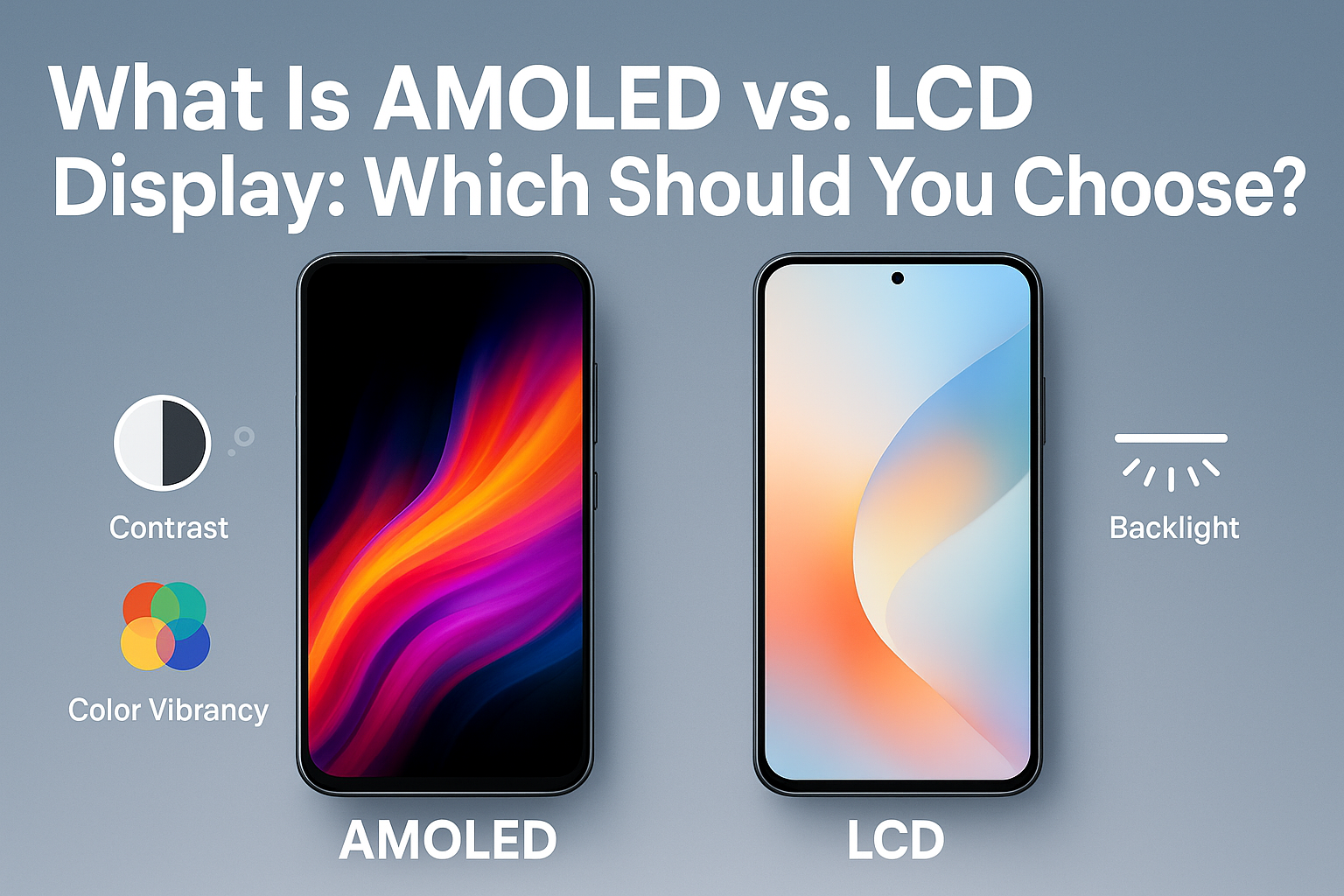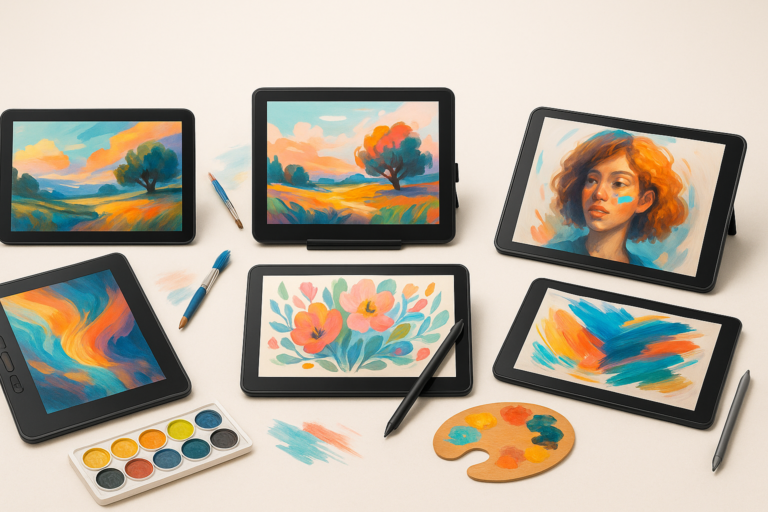Let’s be honest—screens are everything now. They’re the first thing you see when you wake up (those 6:45 AM emails, ugh), and the last thing you glance at before doom-scrolling yourself to sleep. And if you’re like most people, you’ve probably never really stopped to think about what kind of screen you’re staring into.
But here’s the kicker: not all displays are created equal.
You’ve probably heard terms like AMOLED or LCD tossed around in phone reviews or on Reddit threads full of passionate nerds (we say that with love). Maybe you even pretended to understand. No judgment—we’ve all been there.
In this slightly chaotic yet essential guide, we’ll break down the wild world of AMOLED vs. LCD displays. Not just the techy bits (though yeah, those too), but how they feel in real life—when you’re binge-watching Netflix at 2 a.m. or desperately trying to read a WhatsApp message in blinding sunlight.
Wait, So What Is AMOLED?
Okay, let’s start with AMOLED. It sounds like a weird pasta dish, but it’s short for Active-Matrix Organic Light Emitting Diode—try saying that three times fast without sounding like a malfunctioning robot.
Here’s the deal: in AMOLED displays, each pixel lights itself up. No backlight. Just self-contained, pixel-level illumination magic. What does that mean for you?
Well—black is actually black. Not gray pretending to be black. Not “dark mode” black. But black hole in space black. The kind of black that makes colors look like they’re painted on stained glass.
I remember the first time I held a Samsung Galaxy S22 Ultra (it was 2022, the world still felt weird post-pandemic), and I opened a photo of a bonfire. The oranges glowed. The blacks? Bottomless. It was like looking through a window into another dimension.
Quick AMOLED Hits:
- Super rich colors (sometimes cartoonishly so).
- Saves battery if you use dark themes. Seriously, switch your UI to black and watch your battery sigh in relief.
- Ultra-thin. Like, paper-thin. Perfect for foldable phones—yeah, those sci-fi looking ones.
- But… the downsides? Burn-in. It’s real. Use the same app too long, and ghosts of past notifications might linger forever.
LCD: The Reliable, Slightly Dorky Cousin
Now onto LCD—that’s Liquid Crystal Display if we’re being proper. It’s been around since what feels like the Jurassic period of technology. Think Game Boy Color, but way better now.
Instead of each pixel lighting up on its own, LCDs use a backlight. Basically, the whole screen gets lit up, and the liquid crystals play traffic cop—letting more or less light through to make the image.
LCDs are kind of like that friend who always shows up on time and brings snacks. Not flashy, not too emotional, but reliable. They’re in your budget phones, your office monitors, your aunt’s 2018 iPad that somehow still works flawlessly.
Why People Still Love LCD:
- Brighter overall. You’ll notice it in daylight—LCD doesn’t tap out when the sun shows up.
- More accurate colors—sometimes AMOLED gets a little too enthusiastic.
- Longer lifespan. No burn-in nightmares.
- And let’s not forget: they’re cheaper. Not “cheap,” but efficient—like a dependable Honda Civic that just won’t die.
AMOLED vs. LCD: The Showdown (No, Really)
Alright. Let’s lay this out. You’re scrolling fast. You’re impatient. Here’s the quick-fire comparison your brain probably wants:
Image Quality
- AMOLED: Deep blacks, surreal colors. Can look like an Instagram filter you can’t turn off.
- LCD: More “true to life.” Think BBC documentary, not Marvel movie.
Battery Life
- AMOLED: Amazing in dark mode. Awful if you love reading articles on white backgrounds (yes, I see the irony).
- LCD: Consistent. Predictable. Stable power use, no matter what.
Viewing Angles
- AMOLED: Great from the side—colors don’t shift unless you’re really off-axis.
- LCD: Decent, especially with IPS tech. But don’t expect miracles at odd angles.
Durability
- AMOLED: Can be delicate. Pixels burn in if overused. Like a candle burning too bright.
- LCD: Tougher. Less risk of ghost images. The tortoise, not the hare.
Thinness/Flexibility
- AMOLED: Basically yoga for displays. Curved, foldable, wearable. You name it.
- LCD: Thicker. More… “sturdy grandpa” vibes.
Price
- AMOLED: Fancy tech, fancier price tag. Though hey—it’s 2025, and prices are starting to chill.
- LCD: Friendly on the wallet. Especially in budget phones or tablets.
Outdoor Use
- AMOLED: Great in direct sunlight. Contrast = legibility.
- LCD: Bright, yes. But glare is the villain here.
A Not-So-Perfect Table (Because Life Isn’t Perfect Either)
| Feature | AMOLED | LCD |
|---|---|---|
| Blacks | True, deep, dramatic | Slightly washed, depends on quality |
| Color | Wildly vivid—sometimes too much | Balanced and earthy |
| Battery Use | Efficient in dark mode, hungry in light mode | Consistent, but not optimal |
| Durability | Fragile in long-term use | Rock solid (mostly) |
| Flexibility | Fold it, bend it, live your dream | Static rectangle forever |
| Cost | Higher-end, premium feel | Affordable, gets the job done |
| Sunlight Viewing | Excellent in high contrast | Hit or miss (but mostly hit these days) |
So… Which One Should You Pick?
You, yes you, scrolling through this while half-watching a TikTok on your cracked phone screen—here’s the truth:
- If you’re a content junkie, someone who binge-watches YouTube deep dives and wants colors that punch you in the face—go AMOLED.
- If you like your screens like your coffee—balanced, reliable, maybe a little boring but comforting—LCD’s your jam.
- And if budget is tight, guess what? LCD still gives you a pretty darn good experience.
Pro tip: Go to a store. Hold both in your hand. Feel the weight. Watch a trailer for Dune: Part Two. Then decide.
Quick FAQ (Because Someone Will Ask)
Q: AMOLED vs. LCD — what’s the biggest difference?
A: Self-lit pixels (AMOLED) vs. backlight (LCD). That changes everything.
Q: Is AMOLED more battery-friendly?
A: Yes… but only if your screen is mostly dark. If you’re in Google Docs all day, nope.
Q: Can burn-in actually happen?
A: Sadly, yes. Static elements (like nav bars) can haunt your screen forever.
Q: Are LCDs obsolete?
A: Not even close. They’re getting better every year, and still dominate in certain price ranges.
Wrap-Up: The Feels, The Tech, and the Final Word
Picking between AMOLED and LCD is kind of like choosing between two very different travel companions. One’s a stylish, high-maintenance artist. The other’s a steady, no-nonsense engineer. They’ll both get you to your destination—you just have to decide how you want the ride to feel.
And in 2025, with devices getting more advanced, more affordable, and more confusing (why are there three Galaxy S models now?), the screen you pick really does matter. Your eyes are worth it.
So—take your time. Don’t just go by specs. Trust your instincts. Touch the display. Feel the light. Follow the pixels.









